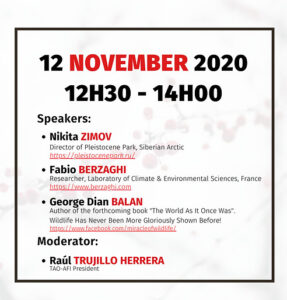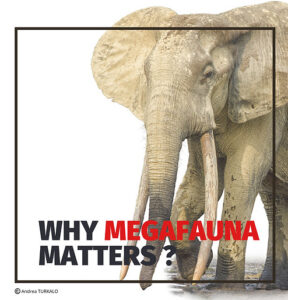TAO-AFI ONLINE CONFERENCE
On 12 November 2020 TAO-AFI organised a conference on
“Fighting Climate Change – Why MEGAFAUNA matters?“.
Near to 250 colleagues registered for this event demonstrating a clear interest for actions related to environmental issues.
The presentations of the three experts raised a lot of interest and we recieved plenty of positive feedback after the conference.
Hereafter a summary of the presentations.
1) Megafauna to prevent permafrost from melting
Nikita Zimov, Director, Pleistocene Park, Siberian Arctic
The Pleistocene Park in Russia attempts to recreate the mammoth steppe. Sergey and Nikita Zimov, father and son, are on the path of demonstrating that grazing ecosystems in the Arctic promote climate cooling through series of ecological effects. The permafrost is a climatic bomb. If the permafrost melts, it is estimated that it will release two times more carbon in the atmosphere than by burning all the world’s remaining forests twice over. Over the 20 years of the experiment, large grazers have created a noticeable effect on the vegetation within certain areas in the Park: “grasses are now the dominant vegetation at many locations, carbon storage in the soil is slowly increasing and rates of the nutrient turnover are accelerating”. Replacing forests and tundra with grassland supporting herds of megaherbivores may look counter-intuitive, but in fact it will lead to less greenhouse gas emissions in comparison to the permafrost-melting scenario.
First, there is permafrost carbon preservation. Large grazers plough the snow in the winter, removing the heat-insulating layer. This allows deeper freezing of permafrost, incredibly important with the longer and warmer summers. When permafrost de-freezes, microbes quickly convert formerly frozen organic matter into greenhouse gases.
Second, there is carbon sequestration. Unlike tundra, grasses form a deep root system. CO2 is absorbed from the atmosphere and stored as grass roots in the cold Arctic soils. This can outperform the storage capacity of trees. Plus, carbon in the soil is not subject to forest fires, which have been ravaging Siberia in the last years.
Third, the albedo effect means that grasslands reflect a higher portion of heat back to the space, in comparison with darker, more heat-absorbing forests.
Finally, reverting to the steppe equals methane emissions reductions. Modern arctic vegetation has slow evapotranspiration, keeping soils moist. High productive grasses dry out soils and prevent methane emissions. In fact, the mammoth steppe was dry.
2) Forest elephants fight climate change in Africa
Fabio Berzaghi, Researcher, Laboratory of Climate and Environmental Sciences, France
Forest elephants are more than gardeners. Believe it or not, they unknowinglymade a mission for themselves to fight climate change. Did you know that forest elephants may render a carbon storage service of US$ 150 billion? By stomping and pushing small trees, even selectively feeding on them, as well as by carrying the seeds of bigger trees, forest elephants favor trees with larger trunk diameters and higher wood densities, which provide higher carbon storage. Carbon stocks in central African forests are enhanced by elephant disturbance. Take forest elephants out, and scientists predict a 7% drop in the aboveground forest biomass. Should they disappear, Africa’s rainforest will lose carbon stocks the equivalent of France’s total CO2 emissions for 27 years.
Fabio Berzaghi and Ralph Chami have calculated that the value of the carbon storage services rendered by a forest elephant in Africa is at least US$ 1.7 million, adopting a conservative approach considering a market price for carbon at one third of that stated by the IMF. Thus, only from that perspective alone, an elephant alive is worth exponentially much more than a trophy hunted or poached elephant. The two scientists further suggest a debt-for-nature swap: an indebted elephant-range country (the debtor) is forgiven part or all of the debt it owes to a rich country (the creditor), when the creditor cares about elephants and the environment. If the debtor fails to protect those elephants, for each elephant killed it will have to pay back US$ 1.7 million.
3) The importance of “trophy” individuals in megafauna species
George Dian Balan, author of the book The World As It Once Was
Trophy hunting has led to the disappearance of the most glorious individuals in iconic megafauna species, which as a result has led to serious consequences for the conservation of those species.
Giant Alaskan bears, African and Asian elephants with tusks-to-the-ground, dark-maned lions, big horned rams or bucks and rhinoceros with over 1 m long horns have almost completely disappeared.
The effect of this “trophy” race, targeting the natural wonders of the animal kingdom, is that the genes of these naturally successful individuals were removed from the species as a whole before they could be bequeathed to the next generations. These “trophy” males in their prime are targeted at exactly the time of their natural breeding peak, and in many species before they can breed at all. The most successful and popular males that are chosen by the females are exactly the same “trophy” males selected to be (prematurely) killed by trophy hunters.
“When you take [trophy animals] systematically out of the population for several years, you end up leaving essentially a bunch of losers doing the breeding” (Festa-Bianchet). The effect of the activity of trophy hunting has therefore already resulted in an active weakening of species all over the globe, by removing the fittest, the best-adapted and resilient individuals, weakening the ability of these species to survive. In an era of habitat loss and climate change, this is the final and perhaps most fatal blow.
TAO-AFI would like to thank most warmly our three speakers for their valuable time as well as all colleagues in attendance.
Do not hesitate to contact us for any additional information.





